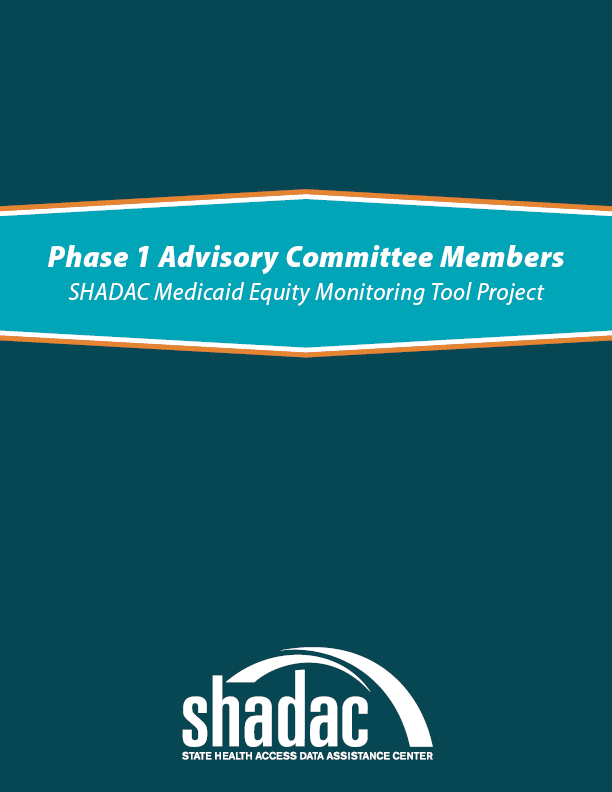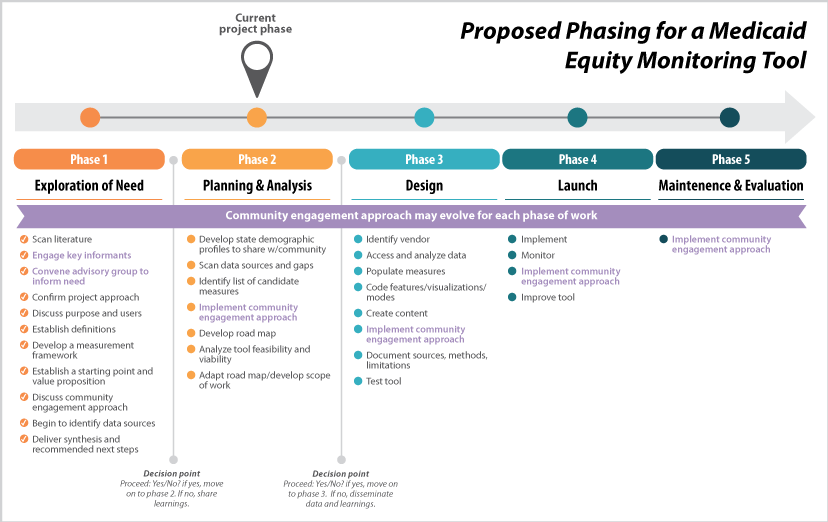Determining the Need for a Medicaid Equity Monitoring Tool
Project Overview
People who experience health inequities based on race, disability, sexual orientation, gender identity, immigration status, and other factors, are a longstanding and pervasive problem that is deeply rooted in discrimination and structural racism. The Medicaid program, through its policy, financial, and programmatic levers, is uniquely situated to address the health inequities experienced by the program’s diverse population of enrollees. Key to these efforts is the availability of comparable state programmatic and performance data to identify and track progress.

With support from the Robert Wood Johnson Foundation, the State Health Access Data Assistance Center (SHADAC) at the University of Minnesota School of Public Health is leading a multi-phased project to assess whether identifying a set of key equity-related indicators and populating them into a centralized “Medicaid Equity Monitoring Tool” could be a helpful, feasible, and reliable way of tracking and advancing health equity in Medicaid. The goal of a potential Medicaid equity data tool is not to replicate other state-level data dashboards or repositories, but to serve as an easily digestible, equity-focused, comparative data resource that could be used both as a monitoring tool to assess progress toward achieving health equity goals in Medicaid and as a catalyst for state-led health equity initiatives.
A future Medicaid Equity Monitoring Tool could be used to:
- Explore differences in access for certain populations of interest across states;
- Set goals and monitor progress;
- Learn from program actions in other states to advance health equity;
- Identify and address state technical assistance needs;
- Shape policy;
- Assess how federal action may affect states; and
- Facilitate conversations in communities about what’s working and what’s not, or where new data are needed.
Advisory Committee
At various stages over the year-long course of the project’s first phase, SHADAC hosted three virtual convenings of the Advisory Committee and held invited and ad hoc conversations with several key partners and informants to discuss a number of aspects, including a measurement framework for advancing health equity in Medicaid, priority measurement concepts and populations of interest, a prospective wireframe (a two-dimensional layout of a product designed to garner response on content and usability), and value proposition for a potential first-iteration tool.
Project Learnings
One of the first lessons that SHADAC project team members learned is that we needed to vastly slow down the pace of our project work in order to: 1) give fuller consideration to the upstream and root causes of inequities as we attempted to define a measurement framework and foundation of a Medicaid Equity Monitoring Tool, and 2) be able to respond to input from project partners in real time and to ensure that the voice of Medicaid community members would be centered in all efforts to conceptualize, design, and build such a tool.
While this project was always intended to span multiple years and multiple phases of work, SHADAC team members made concerted efforts to ensure that the scope of the work accounted for the purposeful involvement of and response to the recommendations and participation of a diversity of voices, including community members, individuals with lived experiences, health equity experts and scholars, data specialists, and other stakeholders.
Currently, the MET project is planned for five phases of work, with two crucial decision points on whether or not the tool could or should be built, as outlined to the right (click the image to enlarge).
Phase 1
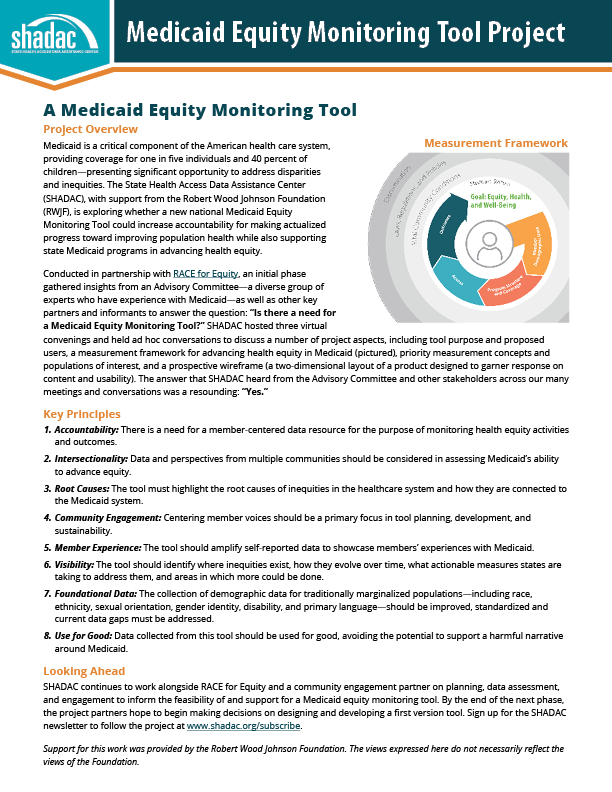 Between May 2021 and April 2022, SHADAC researchers consulted key informants, convened an advisory committee, and conducted reviews of selected literature to carry out the initial phase of this work. Our advisory committee consisted of a purposeful selection of individuals who bring diverse perspectives on the Medicaid program to guide the project and advise about whether and how a Medicaid Equity Monitoring Tool could be most useful and for whom.
Between May 2021 and April 2022, SHADAC researchers consulted key informants, convened an advisory committee, and conducted reviews of selected literature to carry out the initial phase of this work. Our advisory committee consisted of a purposeful selection of individuals who bring diverse perspectives on the Medicaid program to guide the project and advise about whether and how a Medicaid Equity Monitoring Tool could be most useful and for whom.
In preparation for and in concert with Advisory Committee meetings, SHADAC developed a measurement framework for advancing health equity in the Medicaid program with input from the advisory committee. The framework included both potential Medicaid health equity measurement concepts and possible data sources. Phase 1 project work concluded with a wireframe example of what content and features a potential tool could include as well as recommendations on the necessity of a Medicaid Equity Monitoring Tool and next steps in future phases of the project.
For a high-level overview and description of major project milestones, including formulation of project key principles, which will continue to direct our work and future project phases, see our Phase 1 summary to the right (click on image to enlarge).
Phase 1 Products
Linked below are a selection of products developed from the work performed in Phase 1 of the Medicaid Equity Monitoring Tool (MET) project.
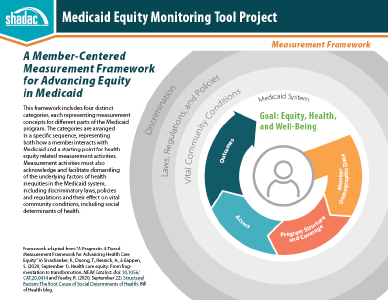
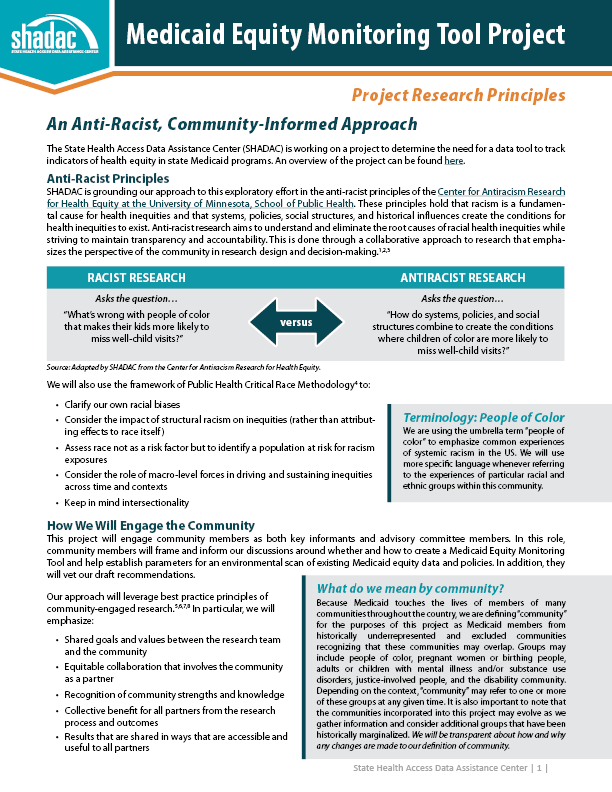 Research Principles
Research Principles
For a closer look at the research principles developed by SHADAC team members alongside our partner, RACE for Equity, that underpinned the approach to Phase 1 work, see our Anti-Racist Research Principles and Member-Centered Measurement Framework to the right (click on images to enlarge).
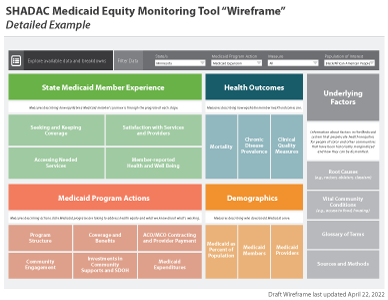
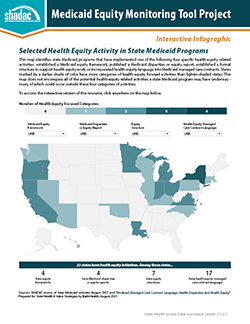 Data-related project work
Data-related project work
For a select highlight of data-related project work, such as a review of state-level health equity actions (as of August 2021) and a high-level conceptualization of a potential tool wireframe developed prior to the final Phase 1 Advisory Committee meeting in spring of 2022, see our materials to the right (click on images to enlarge).
Some of these products were created at a specific point in time and at a certain stage in our approach. As such, certain terminology, goals, or conceptualization of community engagement may have since been adjusted or reconsidered as our work has evolved.
Phase 2 (and Beyond)
While the work of Phase 2 is just beginning, SHADAC is currently in the midst of several exciting project developments.
We are working to select and onboard a partner that will help us ensure that the voices of Medicaid community members, whom we are consistently working to ensure remain at the center of all project work and activities, and are well-represented in all aspects and phases of tool exploration and development. We are hoping that a partner announcement will be forthcoming in spring or early summer 2023.
SHADAC researchers are also currently working to understand what available data measures currently exist that could be useful in populating a Medicaid Equity Monitoring Tool. To begin a process as potentially daunting and as large in scope as this, we decided to narrow our focus to concentrate on one potential category area (i.e., box from the Tool Wireframe, see link above) – Medicaid Member Experience. A variety of reasoning went into making the decision to start with this category.
First, since placing the Medicaid member has been and continues to be at the center of all our project work, so, too, should attempting to understand and capture their experiences be at the center of our measurement data scan and tool population work. We also believe that these data would be the most important in understanding how meaningful these measures are to the Medicaid community members themselves.
Second, because of SHADAC’s extensive background and familiarity working with a variety of federal surveys and other data sources that support state estimates, we knew where to begin in examining data availability and completeness for existing quantitative data. While our research thus far has only accounted for these sources, we are not stopping here, with just the easily accessible and already known measures, but will be pressing forward to examine sources not more readily available or widely known. Through this work we are constantly discovering, and intentionally highlighting major data gaps, and developing recommendations on how to best address these absences.
At the end of Phase 2, the project will reach another decision point, at which SHADAC will make a recommendation, in concert with our partners and community voices, to RWJF on the feasibility of moving forward into the final phases of building, operating, and maintenance of a Medicaid Equity Monitoring Tool.
MET Project Phase 2 Resources
State Medicaid Member Experience Quantitative Data Scan |
State Medicaid Member Experience Qualitative Data Scan |
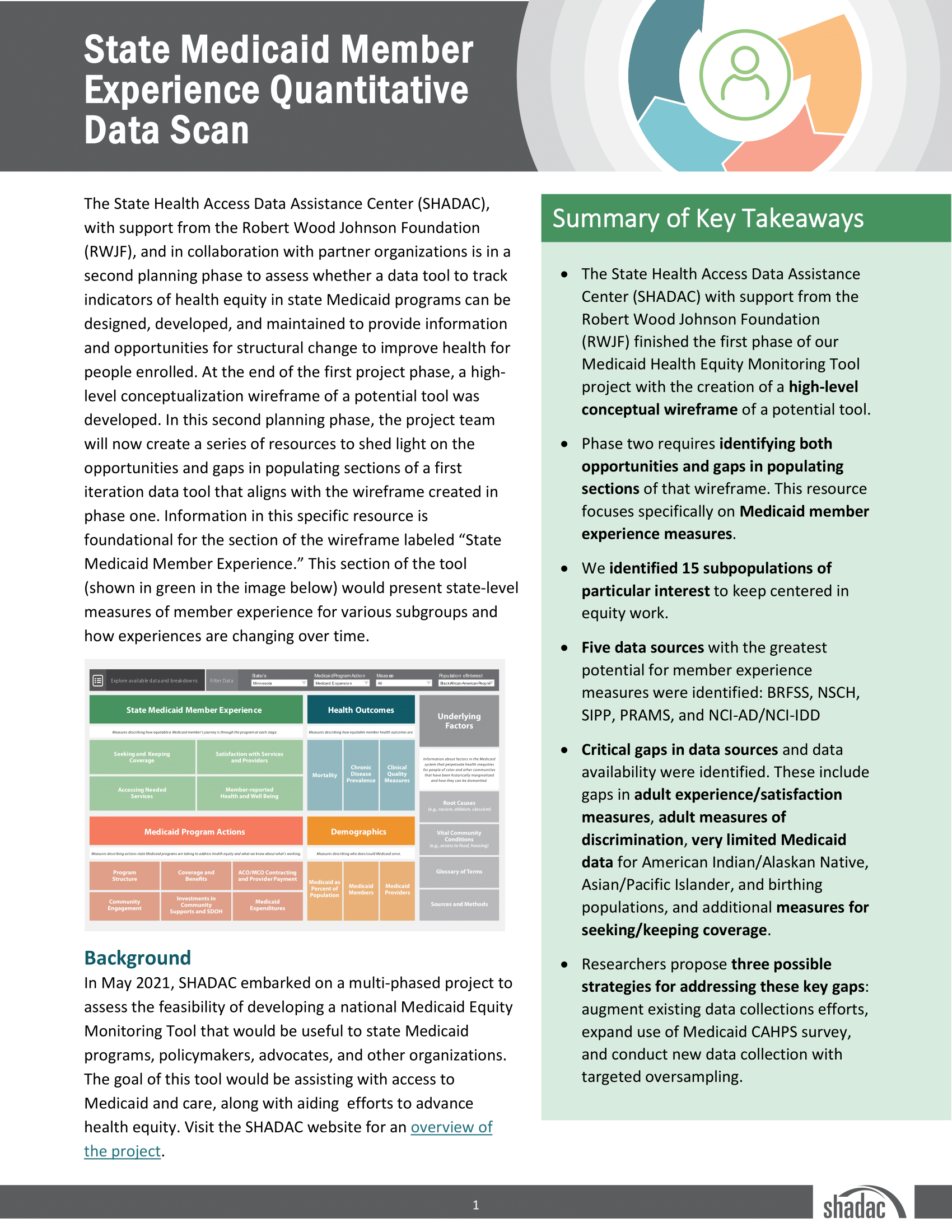 |
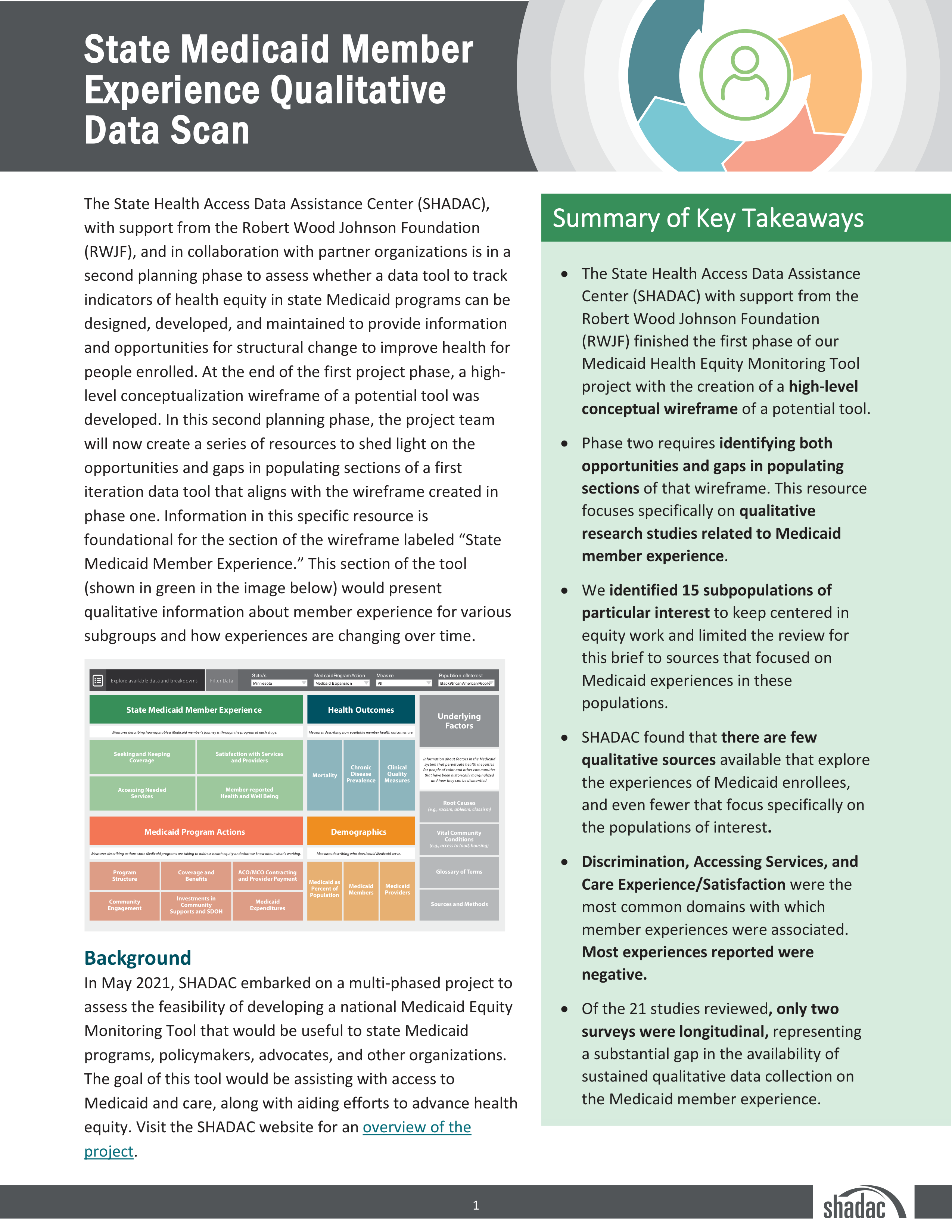 |
Contact Information
For questions, comments, or suggestions about the work of this project, please reach out to either of SHADAC’s Co-Principal Investigators, Dr. Lynn A. Blewett at blewe001@umn.edu, or Christina Worrall at cworrall@umn.edu.
Support for this project is provided by the




